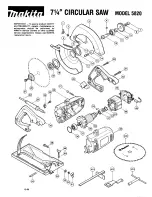
9
FUNCTIONAL DESCRIPTION
CAUTION:
• Always be sure that the tool is switched off and the
battery cartridge is removed before adjusting or
checking function on the tool.
Installing or removing battery cartridge
(Fig. 7)
CAUTION:
• Always switch off the tool before installing or removing
of the battery cartridge.
•
Hold the tool and the battery cartridge firmly when
installing or removing battery cartridge.
Failure to
hold the tool and the battery cartridge firmly may cause
them to slip off your hands and result in damage to the
tool and battery cartridge and a personal injury.
To remove the battery cartridge, slide it from the tool while
sliding the button on the front of the cartridge.
To install the battery cartridge, align the tongue on the
battery cartridge with the groove in the housing and slip it
into place. Insert it all the way until it locks in place with a
little click. If you can see the red indicator on the upper
side of the button, it is not locked completely.
CAUTION:
• Always install the battery cartridge fully until the red
indicator cannot be seen. If not, it may accidentally fall
out of the tool, causing injury to you or someone
around you.
• Do not install the battery cartridge forcibly. If the
cartridge does not slide in easily, it is not being inserted
correctly.
Battery protection system (Lithium-ion
battery with star marking) (Fig. 8)
Lithium-ion batteries with a star marking are equipped
with a protection system. This system automatically cuts
off power to the tool to extend battery life.
The tool will automatically stop during operation if the tool
and/or battery are placed under one of the following
conditions:
• Overloaded:
The tool is operated in a manner that causes it to
draw an abnormally high current.
In this situation, release the switch trigger on the tool
and stop the application that caused the tool to
become overloaded. Then pull the switch trigger
again to restart.
If the tool does not start, the battery is overheated. In
this situation, let the battery cool before pulling the
switch trigger again.
• Low battery voltage:
The remaining battery capacity is too low and the tool
will not operate. In this situation, remove and
recharge the battery.
Indicating the remaining battery capacity
Only for battery cartridges with the indicator (Fig. 9)
Press the check button on the battery cartridge to indicate
the remaining battery capacity. The indicator lamps light
up for a few seconds.
NOTE:
• Depending on the conditions of use and the ambient
temperature, the indication may differ slightly from the
actual capacity.
Adjusting depth of cut (Fig. 10)
CAUTION:
• After adjusting the depth of cut, always tighten the lever
securely.
Loosen the lever on the side of the rear handle and move
the base up or down. At the desired depth of cut, secure
the base by tightening the lever.
For cleaner, safer cuts, set cut depth so that no more than
one blade tooth projects below workpiece. Using proper
cut depth helps to reduce potential for dangerous
KICKBACKS which can cause personal injury.
Bevel cutting (Fig. 11)
Loosen the lever on the bebel scale plate on the front
base. Set for the desired angle (0° - 50°) by tilting
accordingly, then tighten the lever securely.
Sighting (Fig. 12)
For straight cuts, align the A position on the front of the
base with your cutting line. For 45° bevel cuts, align the B
position with it.
Switch action (Fig. 13)
CAUTION:
• Before inserting the battery cartridge into the tool,
always check to see that the switch trigger actuates
properly and returns to the “OFF” position when
released.
• Do not pull the switch trigger hard without pressing the
lock-off lever. This can cause switch breakage.
To prevent the switch trigger from being accidentally
pulled, a lock-off lever is provided. To start the tool, press
the lock-off lever and pull the switch trigger. Release the
switch trigger to stop.
WARNING:
• For your safety, this tool is equipped with lock-off lever
which prevents the tool from unintended starting.
NEVER use the tool if it runs when you simply pull the
Indicator lamps
Remaining
capacity
Lighted
Off
Blinking
75% to 100%
50% to 75%
25% to 50%
0% to 25%
Charge the
battery.
The battery may
have
malfunctioned.
Summary of Contents for DSS500
Page 2: ...2 1 000157 1 2 000154 3 000156 4 000194 5 000147 6 000029 7 013772 8 012128 1 2 3 4 ...
Page 5: ...5 25 007983 25 26 ...
Page 69: ...69 ...
Page 70: ...70 ...
Page 71: ...71 ...










































